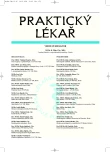Family structure and life style of Czech children
Rodinná struktura a životní styl českých dětí
Autoři referují o výsledcích HBCS studie sledující behaviorální komponenty zdraví u reprezentativního souboru českých dětí ve věku jedenácti až patnácti let. Zaměřují se na vztah mezi rodinnou strukturou a rozvojem některých zdraví ohrožujících návyků. Ze sledovaného souboru 5 012 dětí jich 72,9 % vyrůstalo v úplné rodině, 13,6 % v neúplné rodině, 11,7 % s jedním vlastním a jedním nevlastním rodičem (tzv. doplněná rodina) a 1,8 % bez rodičů. Děti vyrůstající v úplné rodině vykazovaly relativně méně zdraví ohrožujících návyků. Ve srovnání s ostatními dětmi častěji uváděly, že jí společně s někým z rodiny, méně často vynechávaly některé hlavní jídlo, měly více fyzické aktivity, častěji s rodiči sportovaly, méně kouřily, pily alkohol a měly nižší zkušenost s marihuanou. Výsledky studie dokládají, že ztráta jednoho z rodičů představuje rizikový faktor v rozvoji životního stylu dítěte. Ve sledovaném kontextu se rodina projevovala jako komplexní faktor, kde významnou roli hraje i atmosféra v rodině a vzdělání rodičů. Neúplné rodiny překvapivě vykazovaly více společných aktivit a větší kontrolu nad některými rizikovými návyky dětí než rodiny s jedním nevlastním rodičem.
Klíčová slova:
rodinná struktura, neúplná rodina, životní styl, jídelní a pohybové návyky, návyková rizika
Authors:
F. D. Krch 1,2; L. Csémy 2
Authors‘ workplace:
Psychiatrická klinika VFN, Praha
Přednosta: prof. MUDr. J. Raboch, DrSc.
1; Psychiatrické centrum Praha
Přednosta: prof. MUDr. C. Höschl, DrSc.
2
Published in:
Prakt. Lék. 2006; 86(12): 676-680
Category:
Reviews
Overview
Authors refer on the results of the HBSC study monitoring behavioural components of health in a representative sample of Czech children aged from 11 to 15 years. They focus on the relation between family structure and the development of certain health endangering habits. Out of the followed sample of 5 012 children 72,9 % were growing up in a complete family; 13,6 % in an incomplete family; 11,7 % with one biological and one step parent (so-called complemented family) and 1,8 % without parents. The children living in complete families showed relatively less health endangering habits. In comparison with other children they more often stated that they eat their meals together with another family member, they less often skipped one of the main meals, they had more physical activities, they engaged in sports with their parents more often and they less frequently smoked cigarettes, drank alcohol and had lower experience with marijuana. The results of the study document that a loss of one parent represents a risk factor in the development of a child’s life style. In the context of the sample which was studied, the family manifested itself as a complex factor, in which the family atmosphere and the education of parents had also an important role. In comparison with the families with one step parent, incomplete families surprisingly demonstrated more shared activities and higher control over certain risk habits of the children.
Key words:
family structure, incomplete family, life style, eating habits, physical activity, habitual risks
Labels
General practitioner for children and adolescents General practitioner for adultsArticle was published in
General Practitioner

2006 Issue 12
- Memantine Eases Daily Life for Patients and Caregivers
- Metamizole vs. Tramadol in Postoperative Analgesia
- Metamizole at a Glance and in Practice – Effective Non-Opioid Analgesic for All Ages
- Memantine in Dementia Therapy – Current Findings and Possible Future Applications
- What Effect Can Be Expected from Limosilactobacillus reuteri in Mucositis and Peri-Implantitis?
Most read in this issue
- Severe lactic acidosis associated with acute renal failure in a diabetic patient treated with metformin – A case study.
- Role of coronary calcium scoring in a spectrum of examination procedures
- Restoration of hand movement following irreparable radial nerve palsy
- Neurosyphilis
